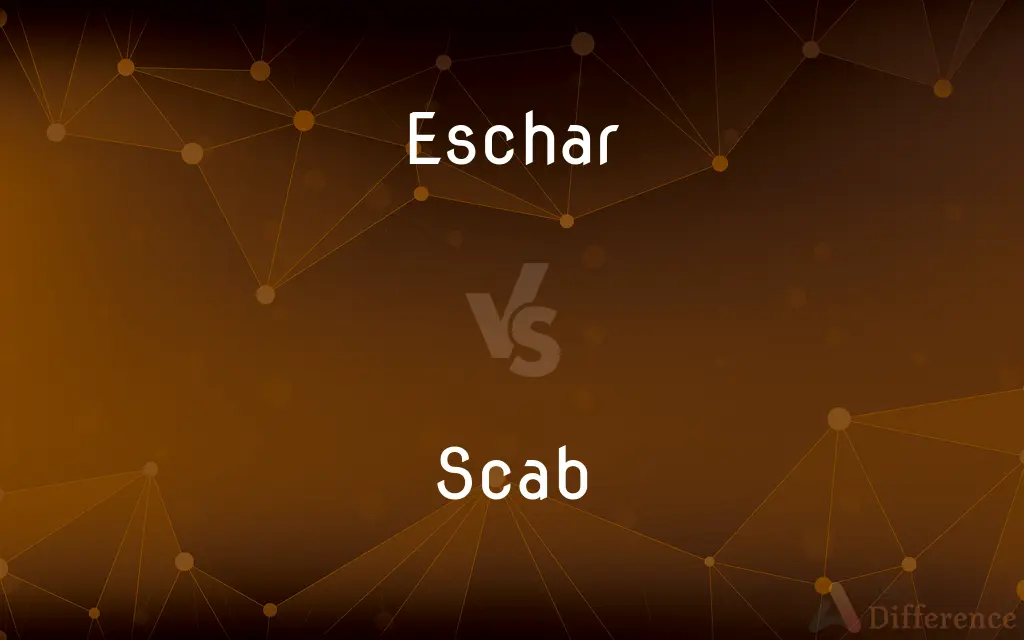Eschar vs. Scab — What's the Difference?
Edited by Tayyaba Rehman — By Maham Liaqat — Updated on April 29, 2024
Eschar is dead tissue resulting from severe burns or gangrene, typically hard and black, while a scab forms over a healing wound, protecting it.

Difference Between Eschar and Scab
Table of Contents
ADVERTISEMENT
Key Differences
Eschar forms when skin or tissue is severely damaged, often from burns or gangrene, and becomes necrotic, creating a thick, leathery layer. Whereas, scabs are a natural part of the healing process, forming when blood clots at the site of a minor wound, such as a cut or scrape, to prevent bleeding and protect against infection.
Eschar is generally associated with more severe medical conditions and may require surgical removal to prevent infection and promote healing. On the other hand, scabs are usually left to fall off naturally as the underlying skin heals and regenerates.
The texture of eschar is typically hard and dry, sometimes described as leathery or mummified. In contrast, scabs are crusty and can be slightly raised, with a rough texture that gradually softens as the wound heals.
Eschar can be a sign of a critical medical issue, especially in cases of severe burns or necrotizing fasciitis, where the dead tissue must be removed to access healthier tissue underneath. Meanwhile, scabs generally indicate minor injuries and a normal, healthy healing process.
In terms of medical management, eschars often require careful observation and treatment in a clinical setting to avoid complications like sepsis. Scabs, however, are typically managed at home with minimal medical intervention, simply keeping the area clean and protected.
ADVERTISEMENT
Comparison Chart
Definition
Dead, necrotic tissue from severe injuries.
Protective crust formed over a healing wound.
Typical Cause
Burns, gangrene.
Minor cuts, abrasions.
Texture
Hard, leathery.
Crusty, rough.
Medical Management
Often requires surgical removal.
Generally heals naturally.
Indicative of
Severe damage, potential severe infections.
Normal healing process.
Compare with Definitions
Eschar
Dead tissue caused by a burn or ulcer.
The nurse explained that the eschar on his leg was due to the third-degree burn.
Scab
A crust that forms over a healing wound.
A scab formed over the scrape on his knee.
Eschar
A sign of severe infection or thermal injury.
The presence of eschar necessitated surgical debridement.
Scab
Result of the blood clotting process.
The scab helps protect the wound from infection.
Eschar
A dry, dark scab or falling away of dead skin.
The eschar was carefully monitored to avoid infection.
Scab
Common in minor injuries like cuts and scrapes.
He picked at the scab, which delayed the healing.
Eschar
Necrotic tissue in wound healing.
Eschar formation is common in severe diabetic ulcers.
Scab
Temporary protection during skin regeneration.
As the skin under the scab heals, the scab will eventually fall off.
Eschar
Typically hard and leathery texture.
The burn wound had developed into a thick, black eschar.
Scab
Indicates normal healing process.
The doctor said the scab signifies that the cut is healing properly.
Eschar
An eschar (; Greek: eschara) is a slough or piece of dead tissue that is cast off from the surface of the skin, particularly after a burn injury, but also seen in gangrene, ulcer, fungal infections, necrotizing spider bite wounds, tick bites associated with spotted fevers and exposure to cutaneous anthrax. The term ‘eschar’ is not interchangeable with ‘scab’.
Scab
A crust discharged from and covering a healing wound.
Eschar
A dry scab or slough formed on the skin as a result of a burn or by the action of a corrosive or caustic substance.
Scab
Scabies or mange in domestic animals or livestock, especially sheep.
Eschar
(medicine) A superficial structure of dead tissue, usually hardened, commonly, but not necessarily dark, adhering to underlying living or necrotic tissue, caused by gangrene or a burn.
Scab
Any of various plant diseases caused by fungi or bacteria and resulting in crustlike spots on fruit, leaves, or roots.
Eschar
(figurative or literary) The emotional imprint of a trauma such as grief, loss, or degradation.
Scab
The spots caused by such a disease.
Eschar
A dry slough, crust, or scab, which separates from the healthy part of the body, as that produced by a burn, or the application of caustics.
Scab
(Slang) A person regarded as contemptible.
Eschar
In Ireland, one of the continuous mounds or ridges of gravelly and sandy drift which extend for many miles over the surface of the country. Similar ridges in Scotland are called kames or kams.
Scab
A worker who refuses membership in a labor union.
Eschar
A dry scab formed on the skin following a burn or cauterization of the skin
Scab
An employee who works while others are on strike; a strikebreaker.
Scab
A person hired to replace a striking worker.
Scab
To become covered with scabs or a scab.
Scab
To work or take a job as a scab.
Scab
An incrustation over a sore, wound, vesicle, or pustule, formed during healing.
Scab
The scabies.
Scab
The mange, especially when it appears on sheep.
Scab
(uncountable) Any of several different diseases of potatoes producing pits and other damage on their surface, caused by streptomyces bacteria (but formerly believed to be caused by a fungus).
Scab
Common scab, a relatively harmless variety of scab (potato disease) caused by Streptomyces scabies.
Scab
(plant disease) Any one of various more or less destructive fungal diseases that attack cultivated plants, forming dark-colored crustlike spots.
Scab
(founding) A slight irregular protuberance which defaces the surface of a casting, caused by the breaking away of a part of the mold.
Scab
A mean, dirty, paltry fellow.
Scab
A worker who acts against trade union policies; any picket crosser (strikebreaker), and especially one with devotion to union busting.
Scab
(intransitive) To become covered by a scab or scabs.
Scab
(intransitive) To form into scabs and be shed, as damaged or diseased skin.
Scab
(transitive) To remove part of a surface (from).
Scab
(intransitive) To act as a strikebreaker.
Scab
To beg (for), to cadge or bum.
I scabbed some money off a friend.
Scab
An incrustation over a sore, wound, vesicle, or pustule, formed by the drying up of the discharge from the diseased part.
Scab
The itch in man; also, the scurvy.
Scab
The mange, esp. when it appears on sheep.
Scab
A disease of potatoes producing pits in their surface, caused by a minute fungus (Tiburcinia Scabies).
Scab
A slight irregular protuberance which defaces the surface of a casting, caused by the breaking away of a part of the mold.
Scab
A mean, dirty, paltry fellow.
Scab
A nickname for a workman who engages for lower wages than are fixed by the trades unions; also, for one who takes the place of a workman on a strike.
Scab
Any one of various more or less destructive fungus diseases attacking cultivated plants, and usually forming dark-colored crustlike spots.
Scab
To become covered with a scab; as, the wound scabbed over.
Scab
To take the place of a striking worker.
Scab
Someone who works (or provides workers) during a strike
Scab
The crustlike surface of a healing skin lesion
Scab
Form a scab;
The wounds will eventually scab
Scab
Take the place of work of someone on strike
Common Curiosities
Can eschar lead to other health issues?
If not properly managed, eschar can lead to serious infections like sepsis, especially in cases of extensive burns or gangrene.
What is a scab?
A scab is a crusty, protective layer that forms over a wound as it heals, resulting from the clotting of blood.
Why does a scab form?
A scab forms to stop bleeding and protect a wound from infection as it heals.
Are scabs harmful to pick at?
Picking at scabs can delay healing and increase the risk of infection or scarring.
What is eschar and how does it form?
Eschar is dead, necrotic tissue that forms typically after severe burns or cases of gangrene, characterized by a thick, leathery appearance.
How do you treat eschar?
Treatment for eschar may involve surgical removal (debridement) to prevent infection and promote healing.
How can you tell if a scab is infected?
Signs of infection include increased redness, swelling, pain, or pus around the scab.
What distinguishes eschar from a scab?
Eschar results from more severe damage and is necrotic tissue, while scabs are part of the natural healing process for minor wounds.
How does eschar affect the body?
Eschar can restrict blood flow and harbor bacteria, potentially leading to severe infections.
What should you do if you have eschar on a wound?
Seek medical attention as eschar might need to be surgically removed to prevent complications.
Is it okay to remove a scab?
Scabs should generally be left alone to fall off naturally to ensure proper healing underneath.
What conditions promote the formation of eschar?
Conditions like severe burns, pressure ulcers, and certain bacterial infections like necrotizing fasciitis can lead to eschar formation.
Can both eschar and scab be present on the same wound?
It's possible, particularly if a wound has varying degrees of severity and healing stages.
How can you care for a wound with a scab?
Keep the area clean and dry, and avoid picking at the scab to allow natural healing.
When should you see a doctor for eschar or a scab?
Consult a doctor if there is severe pain, signs of infection, or if the eschar covers a large area or is due to a severe burn.
Share Your Discovery

Previous Comparison
Holiday vs. Christmas
Next Comparison
Make vs. MakingAuthor Spotlight
Written by
Maham LiaqatEdited by
Tayyaba RehmanTayyaba Rehman is a distinguished writer, currently serving as a primary contributor to askdifference.com. As a researcher in semantics and etymology, Tayyaba's passion for the complexity of languages and their distinctions has found a perfect home on the platform. Tayyaba delves into the intricacies of language, distinguishing between commonly confused words and phrases, thereby providing clarity for readers worldwide.
















































